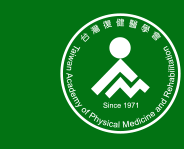Rehabilitation Practice and Science
Translated Title
神經肌肉電刺激在頸髓損傷者姿勢性低血壓的應用
Abstract
Postural hypotension is often observed in patients with cervical spinal cord injury. It may cause syncope, and interfere with sitting and standing trainings. Neuromuscular electrical stimulation (NMES) was reported to be able to alleviate and even prevent postural hypotension. The exact mechanism is not certain yet, but it may be related to vagal reflexes or muscle pumping actions. To investigate the effect of NMES on tetraplegic patients, we have recruited 10 patients with acute cervical spinal cord injuries (American Spinal Injury Association Impairment Scale A and B) suffering from postural hypotension. These patients were randomly divided into 2 groups: four patients in the control group and the other six patients in the NMES group. All patients received conventional rehabilitation programs with tilting table training. The patients in the NMES group also received NMES treatment on bilateral quadriceps and anterior tibialis muscles during tilting table training. The NMES treatment protocol was 30 minutes a day, 5 days a week for a total of 3 weeks. NMES treatment was initiated on the tilt angle that would induce postural hypotension. Heart rate, blood pressure, perceived presyncope score, and tilt angles were recorded before, during, and after NMES treatments. Results showed that NMES treatments in the NMES group significantly increased patients’ systolic and diastolic blood pressures without much influence on heart rate (Wilcoxon sign-rank test, p < 0.05). The NMES group could tolerate higher tilt angle without discomfort or syncope as compared to the control group. Results also showed that the NMES group could reach the 60-degree tilt angle without postural hypotension in a shorter period of time as compared with the control group (11.0 ± 4.7 vs 22.0 ± 9.4 days, Mann-Whitney test, p < 0.05). In conclusion, the results in this study showed that NMES treatments could significantly shorten the period of postural hypotension in patients with cervical spinal cord injuries. Therefore, intensive rehabilitation program can be implemented earlier in patients with cervical spinal cord injury.
Language
Traditional Chinese
First Page
199
Last Page
206
Recommended Citation
Chen, Max J. L.; Cheng, Pao-Tsai; Liaw, Mei-Yun; Wong, Alice M.K.; Wong, Wei-Shung; and Shie, Tshe-Shun
(2003)
"Effect of Neuromuscular Electrical Stimulation on Postural Hypotension in Patients with Cervical Cord Injury,"
Rehabilitation Practice and Science: Vol. 31:
Iss.
4, Article 2.
DOI: https://doi.org/10.6315/3005-3846.2204
Available at:
https://rps.researchcommons.org/journal/vol31/iss4/2


